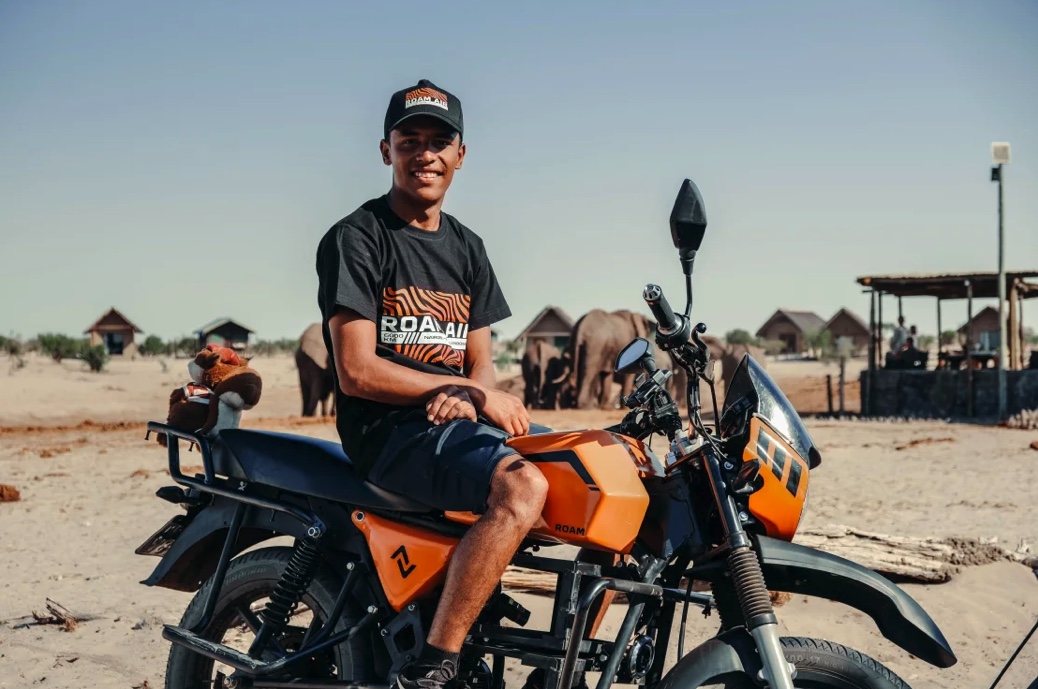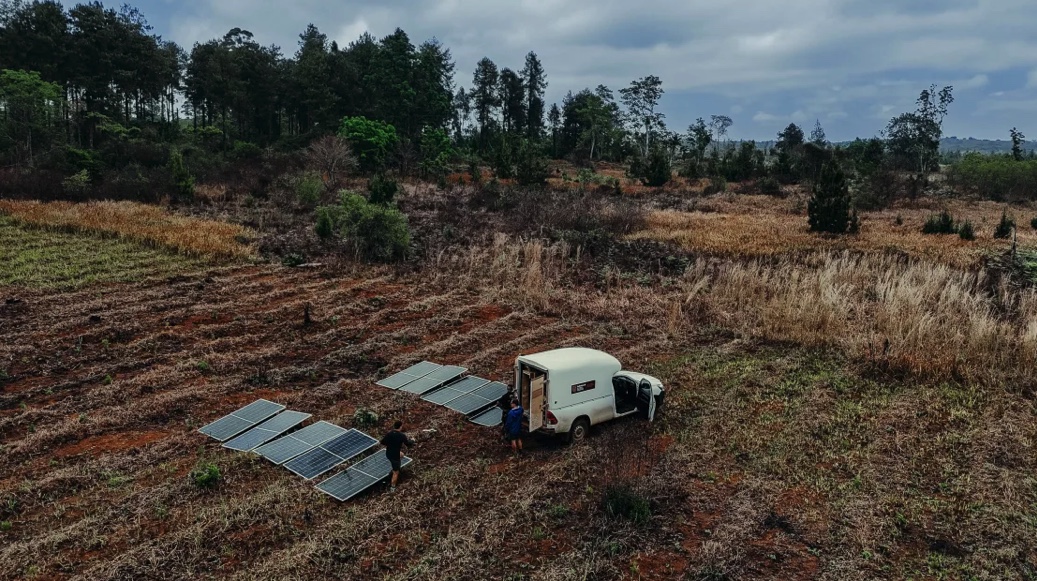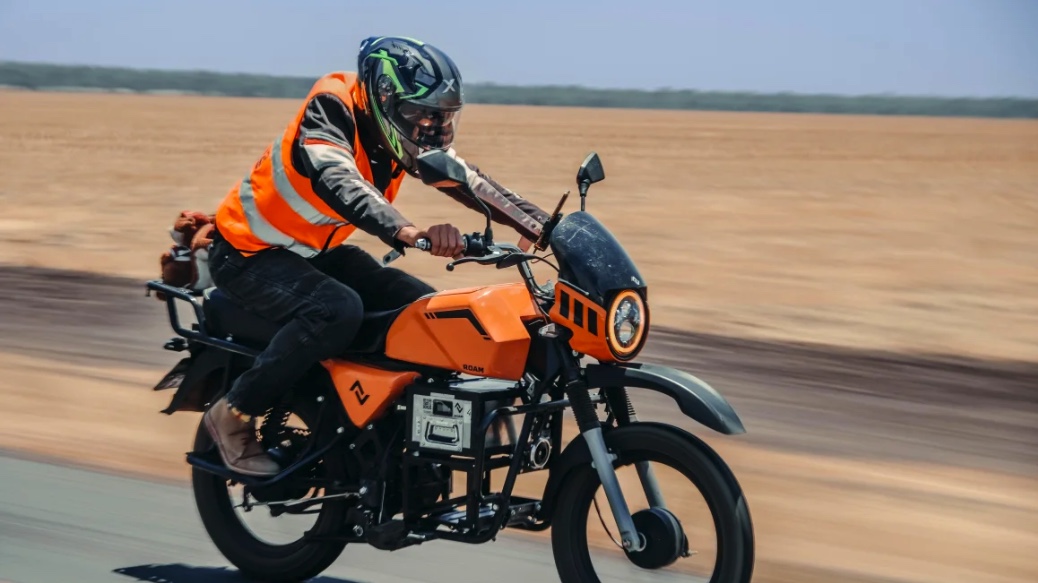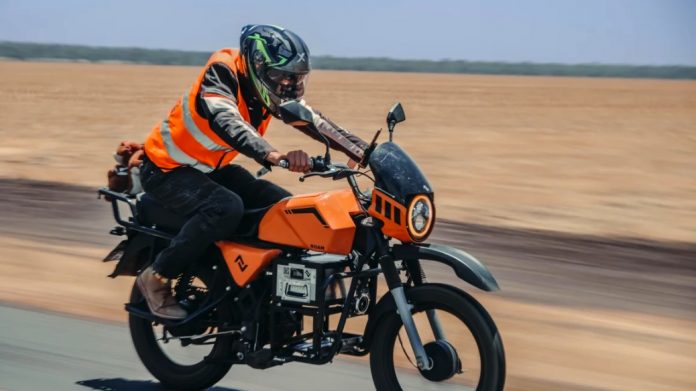มอเตอร์ไซค์ไฟฟ้าที่ผลิตโดย Roam บริษัทผู้ผลิตสัญชาติสวีเดน-เคนยา สามารถปิดฉากการเดินทางจากกรุงไนโรบี ประเทศเคนยา ไปยังเมืองสเตลเลนบอช ประเทศแอฟริกาใต้ ระยะทางกว่า 6,000 กิโลเมตร (3,700 ไมล์) โดยใช้เวลาทั้งสิ้น 17 วัน โดยใช้พลังงานจากแสงอาทิตย์ทั้งหมด
แม้สถิติการเดินทางที่ไกลที่สุดของมอเตอร์ไซค์ไฟฟ้าจะอยู่ที่ระยะทาง 25,000 กิโลเมตร (11,300 ไมล์) ในสหรัฐฯ Roam มุ่งหวังว่าภารกิจครั้งนี้จะช่วยพิสูจน์ศักยภาพของพลังงานหมุนเวียนสำหรับการเดินทางระยะไกลในพื้นที่ที่มีโครงสร้างพื้นฐานการชาร์จไฟน้อย
แบตเตอรี่ของมอเตอร์ไซค์ถูกชาร์จผ่านแผงโซลาร์เซลล์ที่ติดตั้งในรถสนับสนุนซึ่งขับล่วงหน้าไปหยุดรอเพื่อชาร์จแบตเตอรี่ให้เต็มก่อนจะให้มอเตอร์ไซค์เข้ามาเปลี่ยนแบตเตอรี่ที่หมดแล้วเป็นลูกใหม่ ระหว่างการเดินทาง มอเตอร์ไซค์รุ่น Roam Air สร้างสถิติใหม่ด้านระยะการขับขี่ต่อการชาร์จครั้งเดียวถึง 113 กิโลเมตร (70 ไมล์) และในวันสุดท้ายของการเดินทาง ขับขี่ได้ถึง 1,000 กิโลเมตร (620 ไมล์) ในเวลาไม่ถึง 18 ชั่วโมง
“เราอยากทำลายข้อจำกัดในการเดินทางผ่านแอฟริกาโดยไม่ต้องพึ่งโครงสร้างการชาร์จไฟล่วงหน้า” มาสะ คิตูยิ เจ้าของผลิตภัณฑ์ Roam และหนึ่งในนักขับของภารกิจนี้กล่าว
คิตูยิได้แบ่งการขับกับสเตฟาน ลาค็อก นักศึกษาระดับบัณฑิตศึกษาจากมหาวิทยาลัยสเตลเลนบอชซึ่งกำลังทำโปรเจกต์พัฒนาเพาเวอร์เทรนให้ Roam Air ทีมงานเริ่มต้นจากไนโรบีเมื่อวันที่ 29 กันยายน เดินทางผ่านแทนซาเนีย มาลาวี แซมเบีย และบอตสวานา ก่อนจะถึงเมืองสเตลเลนบอชในเช้าวันที่ 16 ตุลาคม ทั้งนี้ ทีมได้เดินทางผ่านทางหลวงและถนนลูกรัง แวะที่น้ำตกวิกตอเรียและแม่น้ำโชเบซึ่งพวกเขาตั้งแคมป์ท่ามกลางธรรมชาติและฝูงฮิปโป
โดยเฉลี่ย ทีมเดินทางราว 400 กิโลเมตร (250 ไมล์) ต่อวัน โดยแบตเตอรี่ 1 ลูกสามารถขับได้ราว 80 กิโลเมตร (50 ไมล์)

อุปสรรคหลักในการเดินทางครั้งนี้คือสภาพอากาศ “เราบังคับให้แดดออกไม่ได้” คิตูยิกล่าว ขณะที่บางจุดพวกเขาต้องเปลี่ยนเส้นทางเพื่อหลีกเลี่ยงเมฆและหาพื้นที่ชาร์จแบตเตอรี่
แม้ Roam ต้องการแสดงให้เห็นถึงศักยภาพของพลังงานแสงอาทิตย์ในการขับเคลื่อนมอเตอร์ไซค์ในพื้นที่ที่ไม่มีโครงสร้างการชาร์จ แต่ลูกค้าส่วนใหญ่ของ Roam มักชาร์จแบตเตอรี่ที่บ้านด้วยพลังงานจากโครงข่ายไฟฟ้า อย่างไรก็ตาม คิตูยิยืนยันว่าการเดินทางนี้ยังสามารถเป็นไปได้แม้ไม่มีรถสนับสนุนติดโซลาร์เซลล์
“ที่ไหนที่คุณชาร์จโทรศัพท์ได้ คุณก็ชาร์จมอเตอร์ไซค์ได้” เขากล่าว “นั่นหมายถึง หากคุณมีการวางแผนที่ดีและพักตามโรงแรมที่มีไฟฟ้า คุณก็สามารถเดินทางด้วยตนเองได้”
อย่างไรก็ตาม เขากล่าวว่าไม่ได้คาดหวังให้ลูกค้าของ Roam เดินทางข้ามทวีป ส่วนใหญ่จะใช้มอเตอร์ไซค์เดินทางระหว่างพื้นที่ชนบทและเมือง การเดินทางนี้เป็นการแสดงให้เห็นถึงความยืดหยุ่นของมอเตอร์ไซค์และลดความวิตกกังวลเกี่ยวกับระยะทางในการขับขี่
การเดินทางครั้งนี้เป็นความร่วมมือระหว่าง Roam และมหาวิทยาลัยสเตลเลนบอชที่เปิดตัวห้องทดลอง Electric Mobility Lab ในเดือนนี้ เพื่อพัฒนาเทคโนโลยีการขนส่งที่ยั่งยืน
Roam บริจาคมอเตอร์ไซค์ 2 คันให้แก่ห้องทดลองเพื่อสนับสนุนการวิจัยและพัฒนาเพิ่มเติม คิตูยิหวังว่าผ่านการทดสอบประสิทธิภาพเพาเวอร์เทรนและ “การทดสอบแบบเร่ง” ซึ่งรวมถึงการชาร์จและคายประจุแบตเตอรี่หลายครั้งต่อวัน บริษัทจะได้ข้อมูลเชิงลึกเกี่ยวกับอายุการใช้งานของมอเตอร์ไซค์และแบตเตอรี่
เขาเสริมว่าการทดสอบแบบเร่งนี้ต้องใช้สถานที่พิเศษ ซึ่งในอดีต Roam เคยทดสอบนอกทวีปแอฟริกา เช่น ที่ประเทศจีน ห้องทดลองนี้จะช่วยให้ Roam สามารถทำการทดสอบในทวีปแอฟริกา ซึ่งน่าเชื่อถือมากขึ้นเนื่องจากอยู่ในสภาพภูมิอากาศที่ใกล้เคียงกัน อีกทั้งยังช่วยสร้างความแข็งแกร่งให้ตลาดยานยนต์ไฟฟ้าในแอฟริกา

จากข้อมูลของบริษัทวิจัยตลาด Mordor Intelligence ตลาดยานยนต์ไฟฟ้าในแอฟริกามีมูลค่าประมาณ 16 พันล้านดอลลาร์สหรัฐฯ และคาดว่าจะเพิ่มขึ้นเป็น 25 พันล้านดอลลาร์สหรัฐฯ ภายในปี 2029 ซึ่งได้รับแรงหนุนจากการลงทุนที่เพิ่มขึ้น ยอดขายยานยนต์ไฟฟ้าที่สูงขึ้น และนโยบายภาครัฐที่สนับสนุนการใช้ยานยนต์ไฟฟ้า เช่น ประเทศรวันดาที่ได้ยกเลิกภาษีนำเข้ายานยนต์ไฟฟ้าและสนับสนุนการพัฒนาโครงสร้างพื้นฐานการชาร์จไฟ
สองล้อถือเป็นส่วนสำคัญ โดยมีความต้องการมอเตอร์ไซค์ไฟฟ้าเพิ่มขึ้นอย่างต่อเนื่อง รายงานอีกฉบับจาก Mordor ระบุว่า ภายในปี 2030 ยานยนต์ไฟฟ้าสองล้อจะมีอัตราการใช้ไฟฟ้าเพิ่มขึ้นเป็น 22% ซึ่งสูงกว่ายานยนต์ประเภทอื่น ๆ ต้นทุนการดำเนินงานที่ต่ำถือเป็นปัจจัยหลัก โดยผู้เชี่ยวชาญจาก Mordor กล่าวผ่านอีเมลถึง CNN ว่า “ไฟฟ้ามีราคาถูกกว่าน้ำมันโดยทั่วไป และมอเตอร์ไซค์ไฟฟ้ามีชิ้นส่วนกลไกน้อยกว่า ทำให้ผู้ขับขี่ประหยัดค่าเชื้อเพลิงได้ประมาณ 400-700 ดอลลาร์ต่อปี จึงทำให้มอเตอร์ไซค์ไฟฟ้าเป็นทางเลือกที่น่าสนใจในเชิงการเงิน”
พวกเขายังเสริมว่า บริษัทสตาร์ทอัพในแอฟริกากำลังครองตลาด เนื่องจากมีการออกแบบมอเตอร์ไซค์ให้ทนต่อสภาพถนนในท้องถิ่น ไม่ต้องพึ่งโครงสร้างพื้นฐานการชาร์จไฟแบบดั้งเดิม และมีตัวเลือกการชำระเงินที่ยืดหยุ่น เช่น Ampersand ในรวันดาซึ่งปัจจุบันมีมอเตอร์ไซค์ไฟฟ้าราว 4,000 คัน และคาดว่าจะเพิ่มขึ้นเกิน 40,000 คันภายในปี 2026 ส่วน Spiro มีมอเตอร์ไซค์ไฟฟ้ากว่า 18,000 คันที่วิ่งอยู่ในเคนยา เบนิน โตโก รวันดา และยูกันดา อีกทั้งยังได้เปิดตัวในประเทศไนจีเรียแล้ว
Roam ก่อตั้งขึ้นในปี 2017 และเดิมชื่อ Opibus ได้เห็นการเปลี่ยนแปลงนี้โดยตรง เริ่มแรก Roam ดำเนินการปรับเปลี่ยนรถซาฟารีให้เป็นรถไฟฟ้า ก่อนจะหันมาพัฒนาและผลิตรถบัสและมอเตอร์ไซค์ ปัจจุบันมอเตอร์ไซค์ถือเป็นผลิตภัณฑ์หลักและมีกำลังการผลิตประมาณ 40 คันต่อวัน มอเตอร์ไซค์เหล่านี้สามารถหาซื้อได้ในไนโรบี และในต้นปี 2025 บริษัทจะขยายตลาดไปทั่วประเทศเคนยา รวมถึงยูกันดา
Electric motorcycle completes solar-powered 6,000-kilometer journey through Africa

An electric motorcycle, made by Swedish-Kenyan manufacturer Roam completed a 6,000-kilometer (3,700-mile) journey from Nairobi, Kenya, to Stellenbosch, South Africa, in 17 days, using only solar power.
While the world record for the longest electric motorcycle journey is 25,000 kilometers (11,300 miles), undertaken over 42 days in the US, Roam hopes that its stunt helps to prove the viability of renewable energy for long-distance travel even in remote areas with poor charging infrastructure.
The batteries were charged en route through a solar panel charging system carried in a support vehicle, which would drive ahead each day, stopping to charge up the batteries, so that when the bike caught up it could swap the dead battery for a fresh one. During the journey, the motorcycle model, the Roam Air, achieved its new single battery record range of 113 kilometers (70 miles), and on the trip’s last day, it traveled 1,000 kilometers (620 miles) in less than 18 hours.
“(We wanted) to break a lot of boundaries on how traversing through sub-Saharan Africa is possible without pre-installed charging infrastructure,” Masa Kituyi, Roam product owner and one of the riders on the expedition, tells CNN. “From Roam’s perspective, we wanted to prove that this ‘ride anywhere, charge everywhere’ ideology is true.”

Kituyi split the riding with Stephan Lacock, a postgraduate student at Stellenbosch University who is working on a powertrain simulation project to boost the Roam Air’s efficiency. Accompanied by two support vehicles, they set off on 29 September, traveling through Tanzania, Malawi, Zambia and Botswana, before arriving in Stellenbosch on the morning of 16 October. The team drove along highways and dirt tracks, stopping off at Victoria Falls and Chobe River, where they camped under the stars and among hippos.
On average the team covered around 400 kilometers (250 miles) per day, with about 80 kilometers (50 miles) per battery.
Cloud cover
The biggest challenge the team faced during the journey was the weather. “You can’t force the sun to shine,” says Kituyi, and at some points they ended up adapting their route so that they could escape cloud cover and have an opportunity to recharge the batteries.
While Roam wanted to demonstrate the potential of solar energy as a solution for powering bikes in areas that lack charging infrastructure, Kituyi says that most of Roam’s customers charge their bikes at home with energy from the grid. However, he insists that this mammoth journey would still be possible for people without a solar support car.
“Anywhere you can charge your phone, you can charge the bike,” he says. “That means with enough planning and lodging in hotels that have electricity, you are able to do this journey yourself.”
However, he adds that he’s not expecting many of Roam’s customers to travel cross-continent – rather, riders might need the bike to travel between rural areas and cities. The feat was about “showing the flexibility works,” he says, and countering range anxiety.

Accelerating market
The journey was a collaborative effort between Roam and Stellenbosch University, which launched an Electric Mobility Lab this month, dedicated to advancing sustainable transport solutions.
Roam donated two motorcycles to the lab to support research and develop the bikes further. Kituyi hopes that through powertrain efficiency tests and “accelerated testing,” which involves charging and discharging the battery multiple times a day, the startup will gain a better understanding of the life cycles of the bike and the battery.
He adds that “accelerated testing” requires special facilities, and in the past Roam has carried out these tests outside Africa, including in China. The lab will give Roam the opportunity to keep the testing within the continent, which he says will make it more reliable as it’s undertaken in a similar climate, as well as helping to build Africa’s electric vehicle (EV) market.
According to market research firm Mordor Intelligence, the African EV market is worth an estimated $16 billion, and it is projected to reach $25 billion by 2029. It claims this is driven by increased investment, rising EV sales, and government policies that encourage electrification. For example, Rwanda has eliminated import taxes on electric vehicles and is offering incentives for charging infrastructure development.
Two-wheelers are a central part of this, with demand for electric motorbikes soaring. According to another report from Mordor, by 2030 the two-wheeler segment of the market is expected to achieve an electrification rate of 22%, significantly higher than other types of vehicles. Low operating costs are a key driver, analysts from Mordor told CNN in an email: “Electricity is generally cheaper than gasoline, and electric motorcycles have fewer mechanical parts. Riders can save approximately $400 to $700 annually on fuel alone, making electric motorcycles an attractive option financially.”
They added that African startups are dominating the space, since they have designed bikes to withstand local road conditions, do not rely on traditional charging infrastructure, and offer flexible payment options. Rwanda’s Ampersand currently has a fleet of almost 4,000 and expects this to surpass 40,000 by the end of 2026, whereas Spiro has over 18,000 e-bikes on the road across Kenya, Benin, Togo, Rwanda and Uganda, and has launched in Nigeria.
Roam, founded in 2017 and formerly known as Opibus, has seen this transition firsthand. It started by electrifying safari vehicles, before turning to buses and motorcycles. Today, motorcycles are its main focus and it produces around 40 bikes a day, according to Kituyi. Currently, the bikes are available to buy in greater Nairobi, and in early 2025, it will be expanding across the whole of Kenya, as well as entering Uganda and Rwanda.
“There is a big demand and constant growth of the market for motorcycles,” says Kituyi, adding that he has seen a gradual shift in people’s mindset. “They are getting more confident with the idea of stopping at a restaurant and asking them for electricity to charge their bike.”
By Nell Lewis, CNN

















